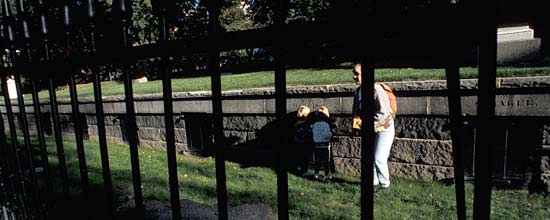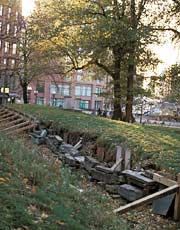

Guidelines for Restoring Cultural Landscapes
Topography

Identify, Retain, and Preserve Historic Features and Materials from the Restoration Period
![]()
Identifying, retaining and preserving the existing topography from the restoration period. Documenting topographic variation prior to project work, including shape, slope, elevation, aspect and contour. For example, preparing a topographic survey.
Evaluating and understanding the cultural landscape’s topography from the restoration period. For example, using archival resources such as plans and aerial photographs or, in their absence, archeological analysis techniques to understand the historic topography.
![]()
Undertaking project work that impacts topography from the restoration period. For example, regrading a cultural landscape without knowledge of historic topography.
Executing project work without understanding its impact on topographic resources from the restoration period. For example, disturbing archaeological resources and watershed systems.
Protect and Maintain Features and Materials from the Restoration Period
![]()
Protecting and maintaining topography from the restoration period by use of non-destructive methods and daily, seasonal and cyclical tasks. For example, applying adequate sediment and erosion controls to protect fragile earthworks from the restoration period.
![]()
Failing to undertake preventive maintenance for topography from the restoration period.
Utilizing maintenance methods which destroy or degrade topography from the restoration period. For example, using heavily weighted equipment on steep or vulnerable slopes.
Repair Features and Materials from the Restoration Period
![]()
Repair declining topographic features from the restoration period. For example, re-excavating a silted swale through appropriate regrading or re-establishing an eroding agricultural terrace.
![]()
Destroying the shape, slope, elevation or contour of topography from the restoration period when repair is possible.
Replace Extensively Deteriorated Features from the Restoration Period
![]()
Using physical evidence of form and detailing to reproduce in-kind an entire topographic feature from the restoration period. If using the same kind of material is not technically, economically, or environmentally feasible, then a compatible substitute material may be considered. For example, re-establishing earthworks around a fort.
![]()
Removing a deteriorated topographic feature from the restoration period and not replacing it; or replacing it with a new feature that does not convey the same visual appearance. For example, changing stepped terracing to a curved slope.
Remove Existing Features from Other Historic Periods
![]()
Removing or altering topographic features from other historic periods. For example, reshaping knolls to their appearance during the restoration period or removing fill to reveal a hollow.
Documenting topographic features from other periods prior to their alteration or removal.
![]()
Failing to remove topographic features from another period, thus confusing the depiction of the landscape during the restoration period. For example, maintaining modern earthen mounds on a historic bowling green.
Failing to document topographic features from other historic periods that are removed or altered so that a valuable portion of the historic record is lost.
Re-Create Missing Features from the Restoration Period
![]()
Recreating a missing topographic feature that existed during the restoration period based on historical, pictorial and physical documentation. For example, recreating a trench and fortification from the restoration period based on stratigraphic research.
![]()
Creating a topographic feature which is incompatible with the restoration period. For example, constructing a topographic feature that was thought to have existed during the restoration period, but for which there is insufficient information; or, constructing a topographic feature that was part of the original design but was never executed, thus creating a false historic appearance.
[top + below] For the Central Burying Ground in Boston, Massachusetts the collapsed free-standing mound tomb, the last of its kind remaining in Boston, was successfully repaired. (Boston Parks and Recreation)
